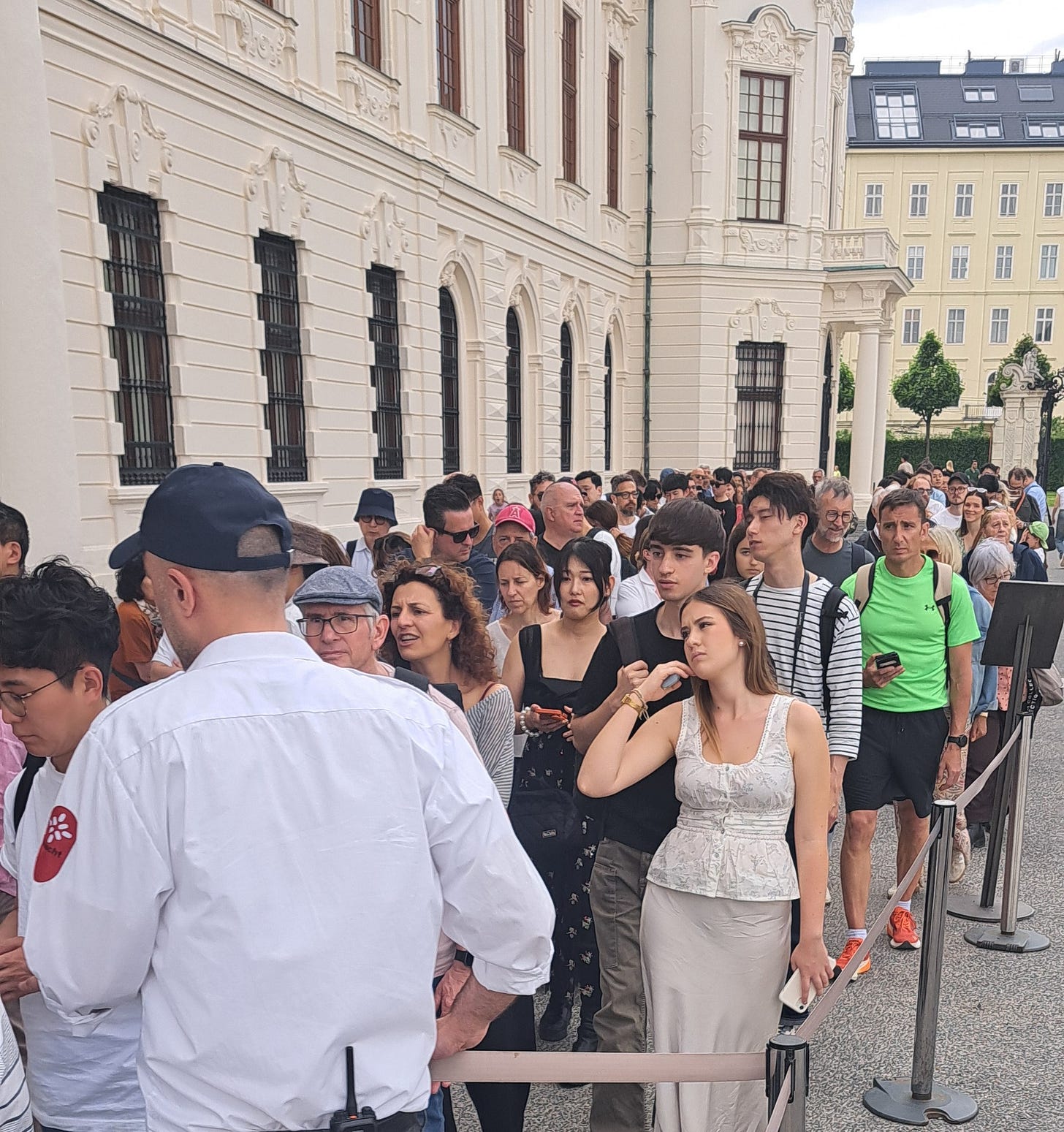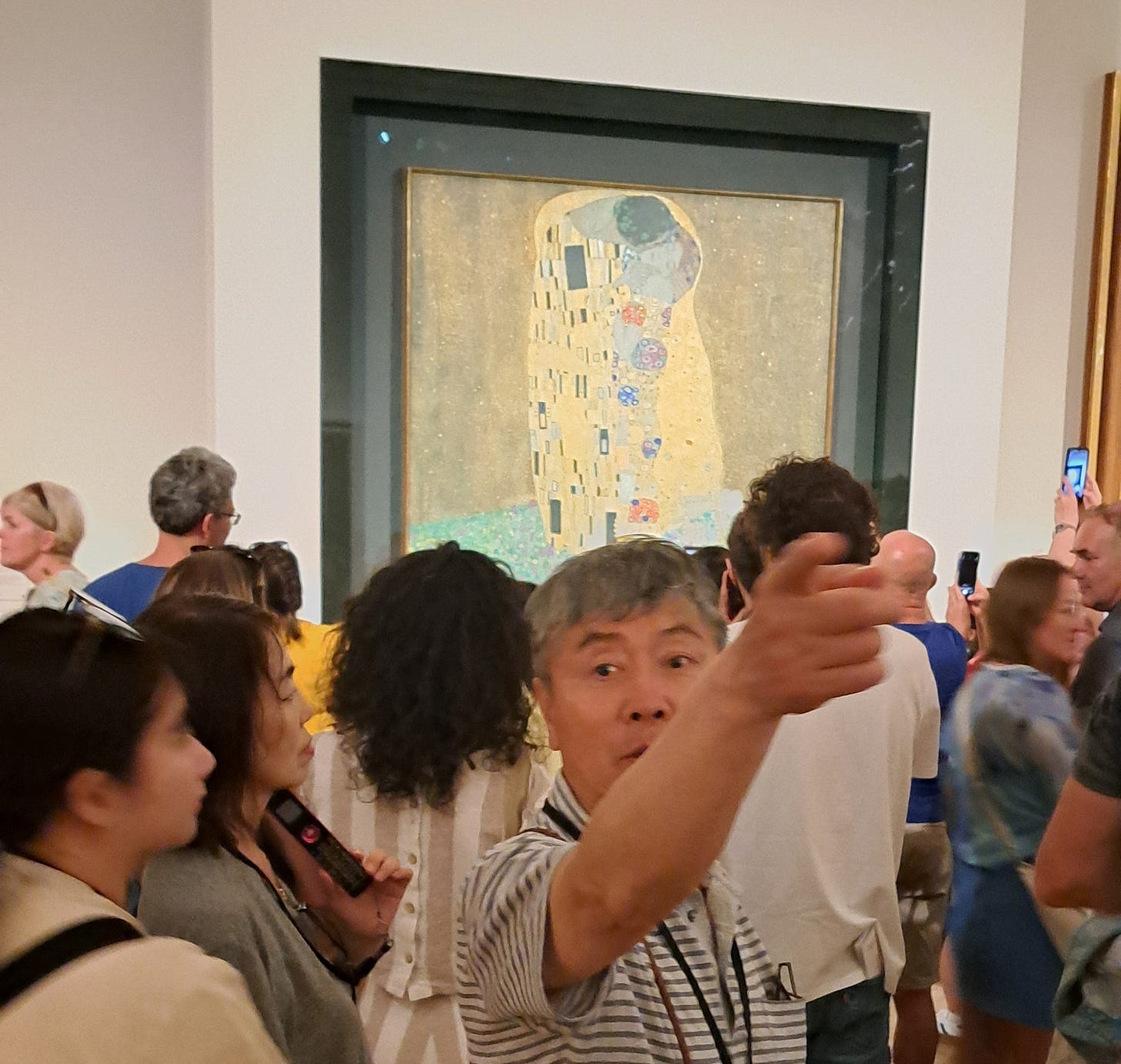Time to charge the world for our Art?
Should Labour reverse two decades of free entry to our leading galleries for tourists?
Recently I stood outside Vienna’s Belvedere Palace art gallery, in drizzling rain, watching as a stream of cash - thousands of Euros an hour - poured in through the Baroque frontage. Even with just an hour to go before closing, there were still 200 people waiting to shuffle through the airport-style, zig-zag queuing system, anxious to pay 16 Euros a head for entry.
And my thoughts immediately turned to Rachel Reeves.
The Belvedere’s a wonderful building, housing a world-famous art collection, so hardly any wonder there is a huge demand for entry. There’s nothing unusual about queues like this wanting to see bucket-list art and willing to pay for the pleasure. I’ve seen these scenes across America and Europe - outside Boston’s Isabella Stewart Gardner Museum, or the Louvre Museum or a hundred other destination-galleries around the globe.
Some people sneer at Culture Tourists - disparaging their urge to get a glimpse of the icons of global art, but I’m all for them. And as Britain’s first female Chancellor of the Exchequer struggles to find cash to plug the growing number of holes which various crises have blown in our national budget, I thought I should suggest Ms Reeves follows in my footsteps round the great cultural attractions of Europe and America.
For one thing, the strain of juggling the country’s finances is beginning to show. She’s not smiling much these days – I think she needs to take a few days off and what better way to re-charge her mental batteries than to gaze at the beauty of fine art? [I wrote this before the tearful incident in the House of Commons, for which Ms Reeves was vilified by many. But not by me.]
There she would find space for calm contemplation away from her almost impossible financial juggling. And - just maybe - the key to a financial windfall which could give a quarter of a billion pound boost to the Treasury’s income. She may even wonder, as I do, why Britain insists on giving the rest of the world a free lesson in art and history which most of the rest of the world charges for?
Back to the Belvedere, home to Gustav Klimt’s “The Kiss” among a constellation of other classic works, and the crowds still queuing to pay for entry as the closing time draws nearer. I agree that the “tick-the-box” syndrome, where visitors make a dash for the key works of art, pausing only long enough for a selfie with Gustav’s lovers before a quick lap of the gift shop, is a bit sad. But we live in a celebrity age, and if cultural Kardashians draw the crowds, well, I’m for it. Prestigious art collections, if they are only ever seen by the cognoscenti, would be pretty sterile and rather pointless.
So I rejoice at the queuing crowds who are prepared to put up with the discomfort of an hour’s wait in the drizzle to secure their first-hand experience of great artworks. Their enthusiasm certainly wasn’t dampened by the scrums they faced inside the galleries.
Vienna’s galleries, outstanding as they are, are no match in their ability to lure cultural tourists, compared with what we have here in London. Austria attracts just a fraction of the visitors our National Gallery, the British Museum, Tate Britain or the fabulous Natural History and Science Museums can pull in. Sadly, none of the visitors to those London venues are clutching £20 notes or their Amex cards. Tourists don’t pay to see British national treasures. It’s all laid on free, courtesy of the UK’s Department of Media, Culture and Sport.
Some of the great attractions have always been free - the British Museum for instance. But it wasn’t always the case that most leading UK cultural attractions were free to enter. It’s been this way for many of them since 2001, when the Blair Government introduced a then £100m annual subsidy to 19 major galleries and museums. It was the keystone achievement of Chris (now Lord) Smith, when the Arts won a seat in the Blair cabinet, and the scrapping of entrance fees was trumpeted as the “democratisation of culture”.
Why do I raise this issue now? I’m usually fine with almost anything which increases footfall in museums and galleries - particularly if these initiatives are focussed on the growing minds of up-coming generations. I remember my first teenage visit to Birmingham Art Gallery and the punch-on-the-nose impact of its Pre-Raphaelite collection. I can still feel the thrill of seeing the vivid story-pictures by Hunt and Millais and Brum’s home-grown Burne-Jones - I truly want that for today’s teenagers. So their free entries are absolutely fine by me.
But we are no longer in the New Camelot of Blair’s Britain. Today’s spending choices are much tougher and the consequences for those causes which don’t catch the eye of Labour’s ministers far more cruel. It was obvious long before the recent internal Labour rows about winter fuel allowance and the proposed changes to PIP payments that there simply isn’t enough cash coming in to the Treasury to cover normal spending. And we can forget making any meaningful improvements to the NHS or to social care. There isn’t enough money in the public purse to pay for gestures of political popularity – Keir Starmer’s Government has a list of priorities stretching much further than its funds can reach.
If you don’t agree with me - here’s a challenge. Where would free museum entrance come on your list of priorities? Above defence, in this freshly dangerous world? Above the drive to cut NHS waiting lists and improve care of the elderly? Above providing decent homes for hundreds of thousands of children? OK - this isn’t a really fair question, but it illustrates why I have become uncomfortable about the considerable loss of visitor revenue from giving free entry to cultural venues to every single visitor whether they are kids on a school or wealthy tourists cabbing it round London from their 5 Star hotels.
How much does Britain lose by its free entry policy?
Obviously there is no empirical evidence for what would happen if overseas visitors were charged for entry to UK institutions, but in 2019 there were 50 million visits in total to our national museums and galleries. The minimal data which is publicly available suggests that between a half and a third of those visits are by tourists, more so in London than elsewhere. So let’s take the lower percentage and trim off a bit more to be conservative – 15 million would seem a fair estimate of potential payees. What would we charge? Well, quality museums and galleries in major countries charge between £15 and £25 – so again let’s take the lower number.
All this would imply that the British government subsidises tourists by some £225 million a year.
Why has nobody suggested this before?
Well, they have. But such views do not get a lot of airtime in culture-focussed media - and none at all in the general press. For instance, Mark Jones, the former head of Victoria & Albert Museum and an interim Director of the British Museum, raised it last year. And, in response to calls such as his, a lobby group called the Cultural Policy Unit recently published a report The Value of 'Free for All': The Price of Charging Overseas Visitors Admission to UK National Museums.
Their report says that introducing fees for overseas tourists would present both ethical and practical challenges for the sector that could “prove both detrimental and costly to the UK’s museum ecosystem and reputation” and damage the UK’s “unique cultural ethos of openness, inclusivity and accessibility – founded on a centuries’ old principle”
They also claim that introducing tourist charging is “is fraught with significant financial, economic and experiential risks.”
There is evidence that it might even be a positive move.
There’s an old Yorkshire saying which springs to mind : “You don’t get owt for nowt”. In other words something which comes with a price is often more appreciated than something free. People don’t queue for hours at the Belvedere because they think they are being ripped off.
And there’s an interesting fact from one national UK institution, outside the Government’s free admission, the Imperial War Museum in London. It had 396,000 visitors in 1987. Two years later it introduced admission charges and the figures rose to 412,000, and last year attracted 444,000.
Food for thought?
.






Interesting point Peter and having not been back too long from Italy wonder why the UK hasn't more widely introduced a tourist tax. I calculated I paid over €100 in such taxes for Sarah and my 7 nights stay. And of course we still paid to go into galleries etc. Not sure how the likes of the NG would operate a tourist charge (UK resident s offering proof of residence / nationality - passport, driving licence - not so straight forward in a country that doesn't universally have photo ID) and as a general point I think charging everyone in the UK to access 'national' art would deny those of lower income (as I once was) a chance to appreciate great art. I see theatre and concert going, becoming more and more art forms for those of wealth (especially in London). I'd hate to think painting and sculpture going the same way, but you make a valid argument re tourist charges that is worth exploration.
Thanks for your comment, Josie. Like you I believe it's perfectly OK (even our duty) to challenge the status quo. It would be wonderful if some fountain of philanthropy was discovered which would mean every gallery or collection could open it's doors for free. In this world, however, we have to prioritise - and how we do that is a legitimate discussion!